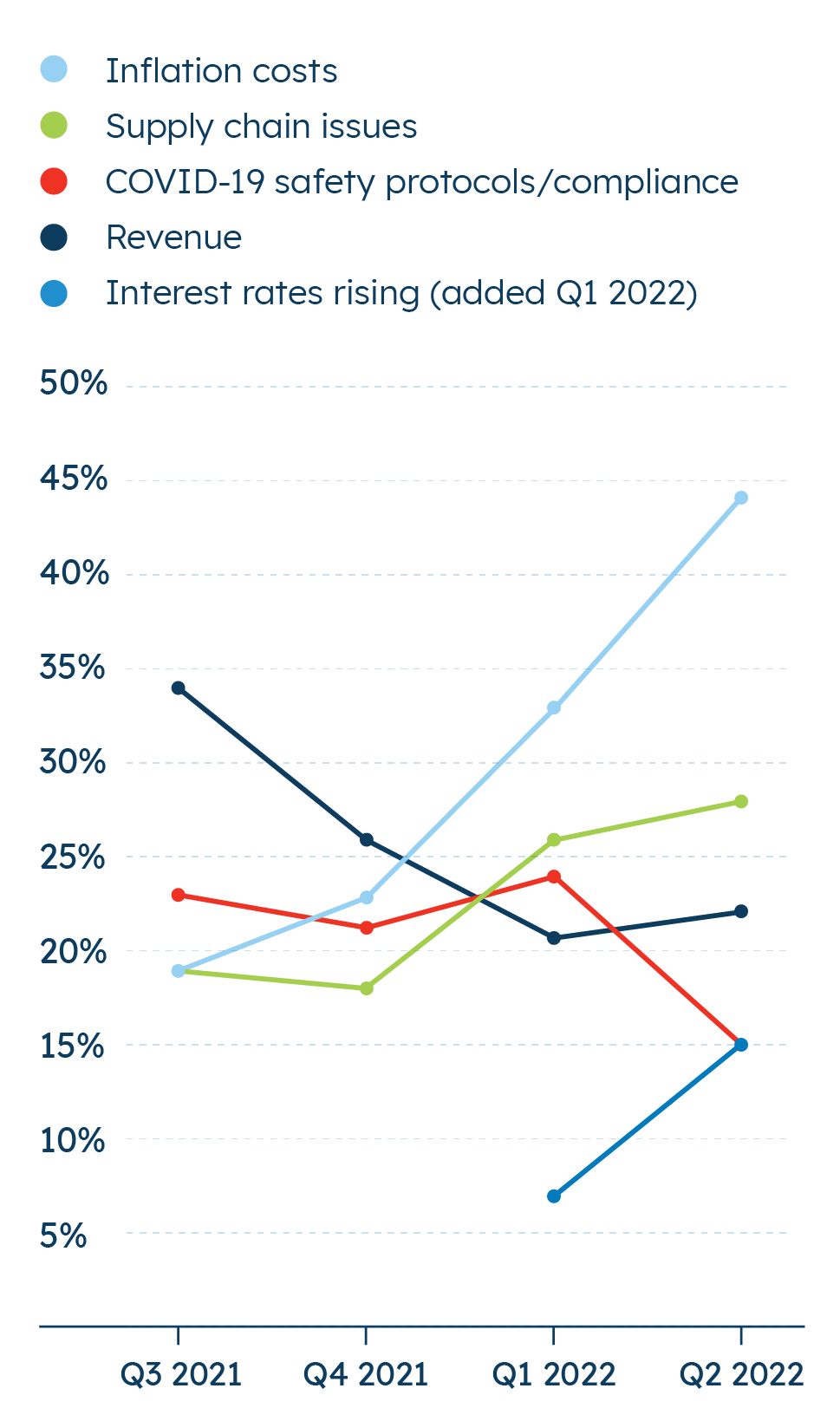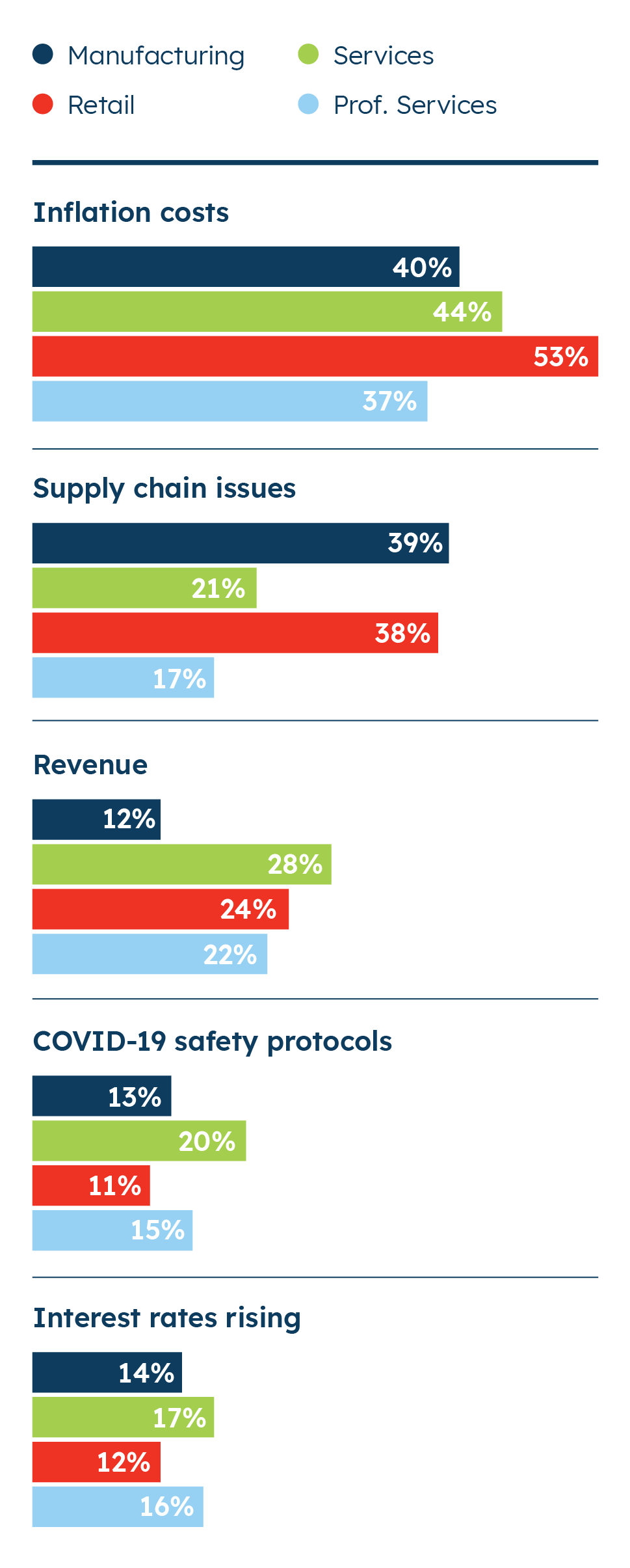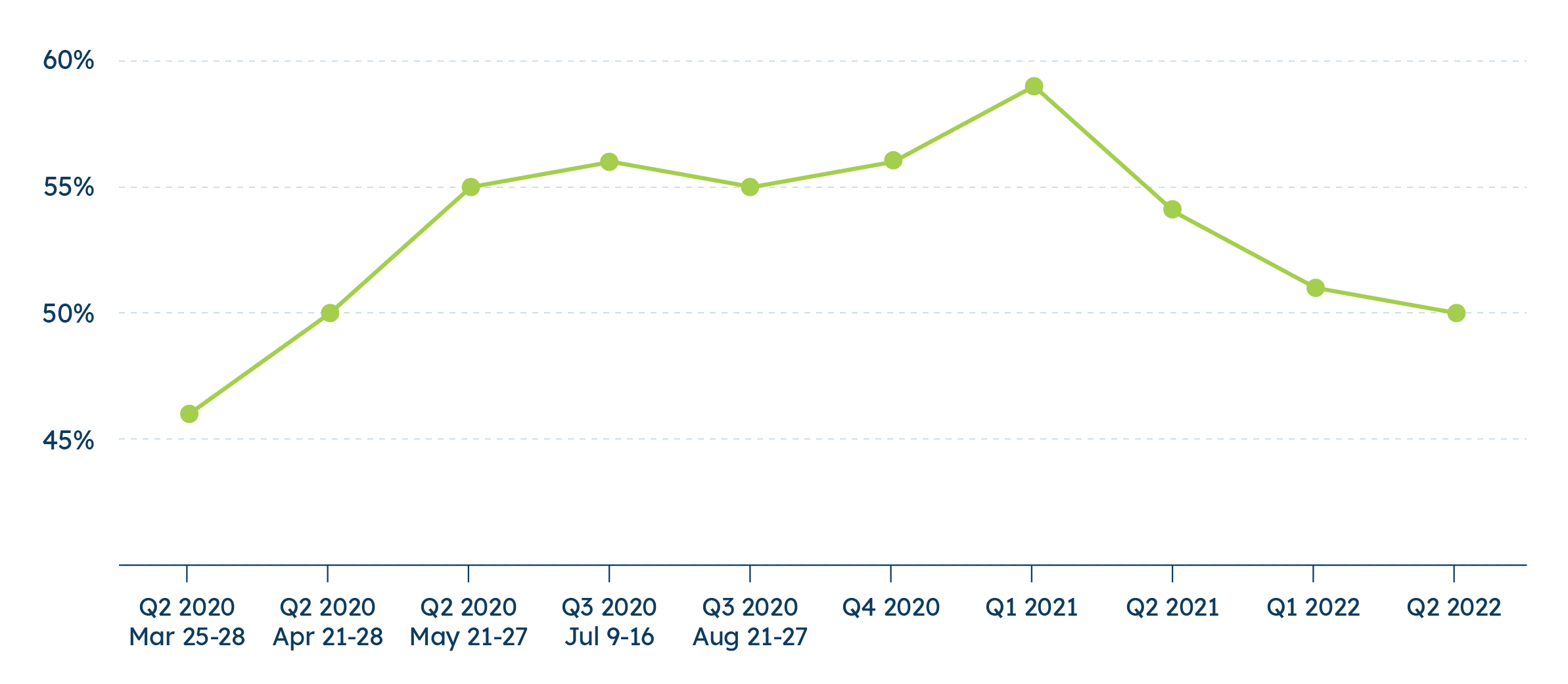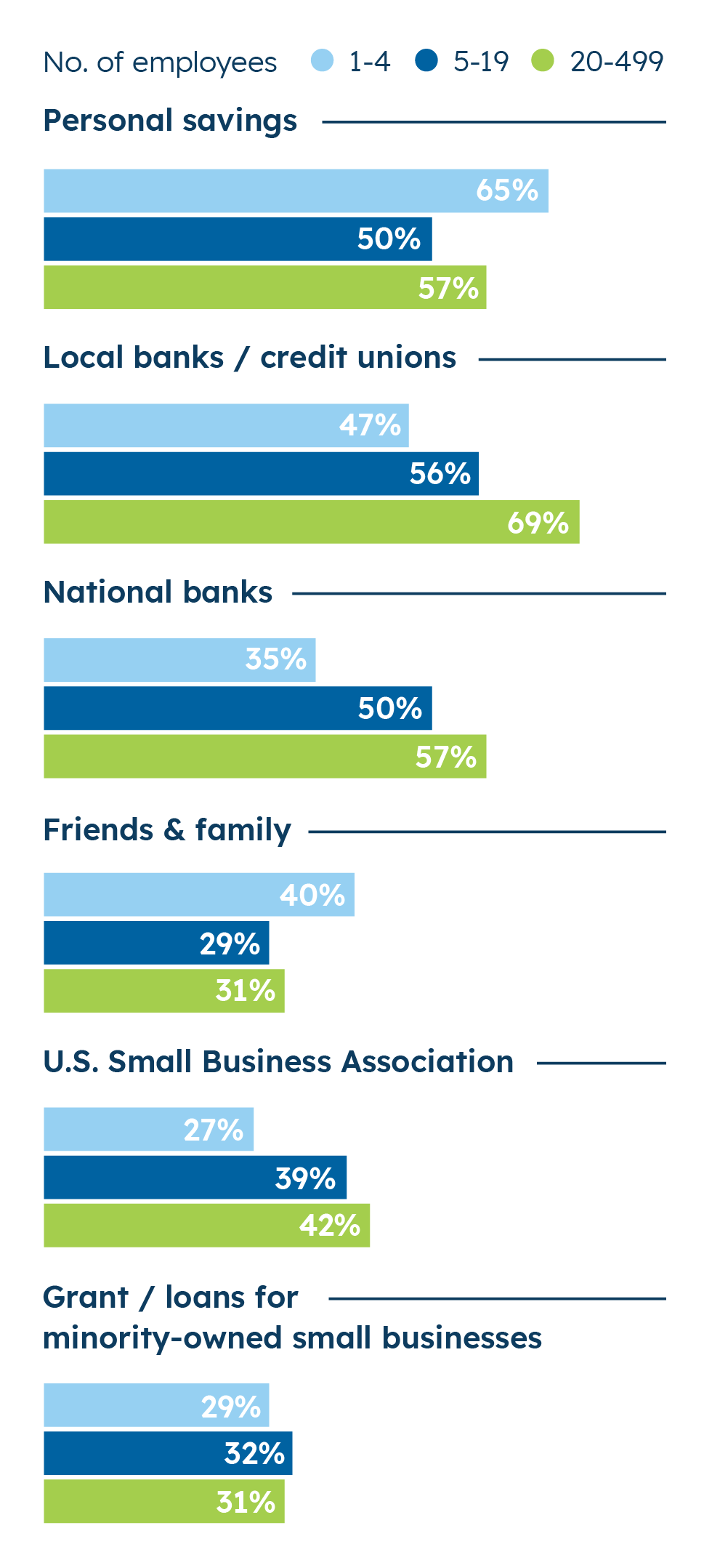Inflation Is Dominant Concern for Small Businesses across Country

Supply chain issues come in second
This quarter, more than two in five (44%) indicate inflation is the top challenge facing the small business community, an 11-percentage point increase from Q1 2022 and a 21-percentage point increase from Q4 2021. Supply chain issues (28%) and revenue (22%) remain in the top three, but they are now in a distant second-tier behind inflation.
Nearly nine in ten small businesses (88%) are concerned about the impact of inflation on their business, with almost half (49%) indicating they are very concerned (up from 44% in Q1 2022 and 31% in Q4 2021). The share of small businesses that report rising prices have had a significant impact on their business continues to rise—up to 80% this quarter compared to 74% in Q1 2022.
Inflation is the top concern for small businesses regardless of their location, number of employees, or sector. However, managing inflation has become more challenging for some compared to last quarter. Significantly more small businesses in the Midwest and West report inflation as a top challenge compared to last quarter (up 13 percentage points and 12 percentage points, respectively). Inflationary pressures have also had a disproportionate impact on small businesses in retail compared to last quarter (up 21 percentage points) and—with 53 percent saying inflation is a big challenge—significantly above other sectors.


Small businesses respond to inflation by raising prices
The most common way for small businesses to respond to inflation is to raise the prices they charge for goods and services.
Sixty-nine percent of small businesses surveyed report raising the prices of their products or services due to inflation in the past year. This is consistent with the 67% that reported raising their prices due to inflation last quarter. Nearly half (46%) report having taken out a loan to cover higher costs due to inflation (up from 39% in Q1 2022). While inflation continues to impact small businesses, fewer now say they have decreased staff to cope with higher prices than in Q1 2022 (35% vs. 41%).
Responses to inflation vary somewhat by sector and region. Those in the services sector are the least likely to report raising prices to offset rising costs. They are also less likely to report having laid off staff in response to rising prices (25%) than professional services (45%) and manufacturing small businesses (39%). Professional service (62%) and manufacturing (59%) small businesses, on the other hand, are more likely than retail (37%) and services (29%) small businesses to have taken out a loan in response to inflation. Meanwhile, small businesses in the West are more likely to report having reduced staff due to inflation than those in other parts of the country. More Western small businesses also report taking out a loan than those in the South and Midwest.

More small businesses get concerned about rising interest rates
Following the Federal Reserve’s decision to raise interest rates in March and May (as this poll was in the field), nearly three-quarters of small businesses (74%) report being concerned about the impact of rising interest rates on their business. Compared to last quarter, there has been a six-percentage point increase in the share that is very concerned (35% vs. 29%).
Also, 15% of small businesses indicate rising interest rates are the top concern for the small business community, more than double from last quarter (7%).
Fewer small businesses in the Midwest (65%) indicate they are concerned over rising interest rates than those in the Northeast (80%) and West (78%). More small businesses in the professional services (83%), manufacturing (75%), and retail (74%) sectors report being concerned about rising interest rates than those in services (63%).

Half see months before things return to normal
Around half of small businesses think it will be six months to a year before the small business environment returns to normal—a statistic that has been remarkably consistent since the pandemic began.
Half (50%) of small businesses say they believe it will be another six months to a year until the U.S. small business climate returns to normal, and fewer than one in ten (6%) say that it already has.

40% offer hybrid work, but only half will continue it indefinitely
Most small businesses say they are concerned about finding and retaining workers.
This quarter, a majority of small businesses (55%) express concern over filling empty roles and retaining employees (54%). That said, half (50%) consider the pool of potential recruits to be of good or very good quality. However, with inflation and supply chain issues dominating their concerns, fewer are citing a lack of applicants for job openings (7%) as a top challenge for the small business community (down from 13% in Q1 2022). Furthermore, a relatively small share say employee morale (10%), employee retention (9%), and low-quality applicants (7%) are a top concerns.
The most popular options for recruiting and retaining workers are to offer flexible work schedules and higher wages. Roughly a third of small businesses report offering employees greater flexibility (34%) and increased wages (33%) over the past year to improve retention and attract new talent.
In addition, four in ten (40%) small business owners say they are still offering their employees a hybrid work environment. This is especially common among small businesses with greater than five employees and those in the services sector. Manufacturing small businesses, on the other hand, are far less likely (27%) to report still offering hybrid work than those in services (52%), retail (42%), and professional services (38%). Of small businesses still offering hybrid work, 54% plan to continue to offer it indefinitely.
Mental health offerings from small businesses have also been boosted this quarter. This quarter, slightly more small business owners say they have offered or expanded their mental health benefits, such as mental health days, wellness activities, and coverage for therapy than in Q1 2022 (20% vs. 14%).
More small businesses in the professional services (25%) sector report offering or improving mental health benefits in the last year to retain and attract employees than those in retail (16%). Similarly, millennial-owned businesses (28%) are more likely than businesses owned by Gen Xers (12%) and baby boomers (13%) to report expanding their mental health benefits.
Ham Lake, Minnesota
COVID-19 fades as a top concern
Many small businesses (68%) report continued concern over the impact of COVID-19 on their business. However, when forced to choose the most pressing challenges facing the small business community, the virus has fallen to a third-tier concern, behind financial challenges like inflation, supply chain issues, and revenue.
Roughly one in six (15%) small businesses cite COVID-19 as a top challenge that small businesses are facing now. This marks the lowest level since we first asked the question in Q3 2021.
Small businesses in the West (78%) are significantly more concerned about COVID-19’s impact on their business than those in the Midwest (58%) and South (65%). Similarly, professional service small businesses (77%) are more concerned than those in retail (67%), manufacturing (65%), and services (63%).
Small businesses turn to personal finance, local banks for financing
Small businesses with fewer than five employees disproportionately rely on personal savings (65%) compared to other sources to finance their business than small businesses with more employees. Meanwhile, larger small businesses (20-499 employees) most often turn to local banks or credit unions (69%) in comparison to relying on personal savings or national banks (both at 57%).
While small businesses report turning to more sources for capital than before the pandemic, they consider the quality of their access as worse. Forty percent report having good access to capital or loans, while another 14% indicate they have very good access. This represents a stark decline in the share of small businesses that rate their access to capital as very good (14% vs. 33%) compared to when we first asked this question in our inaugural SBI (Q2 2017).
At the same time, they face additional challenges that are hindering their access to capital: 60% say that rising interest rates are limiting their access, while 56% say rising prices limits access to funding.


Half of the small business owners work more than five years ago.
This edition of the SBI marks the five-year anniversary of the Small Business Index.
Over that time, one key finding stands out: Half (50%) of small business owners say they are working more hours now than they were a year ago. This question was first asked in the inaugural SBI (Q2 2017). In the pre-pandemic world, five years ago, 30% said they were working more hours. This equates to a 20-percentage point increase2 in the share of small business owners that report working more hours.
Los Angeles, California


